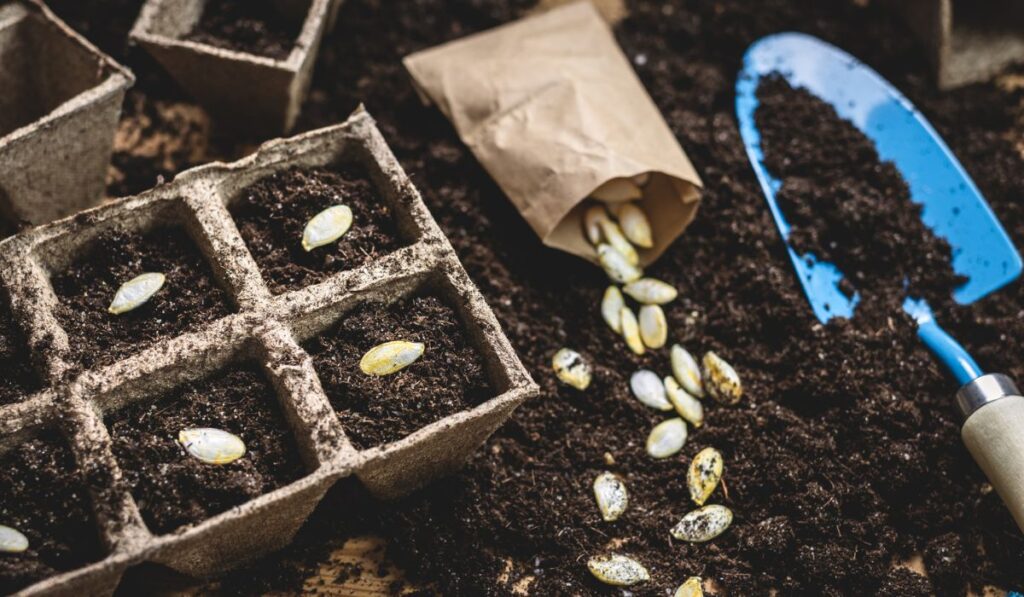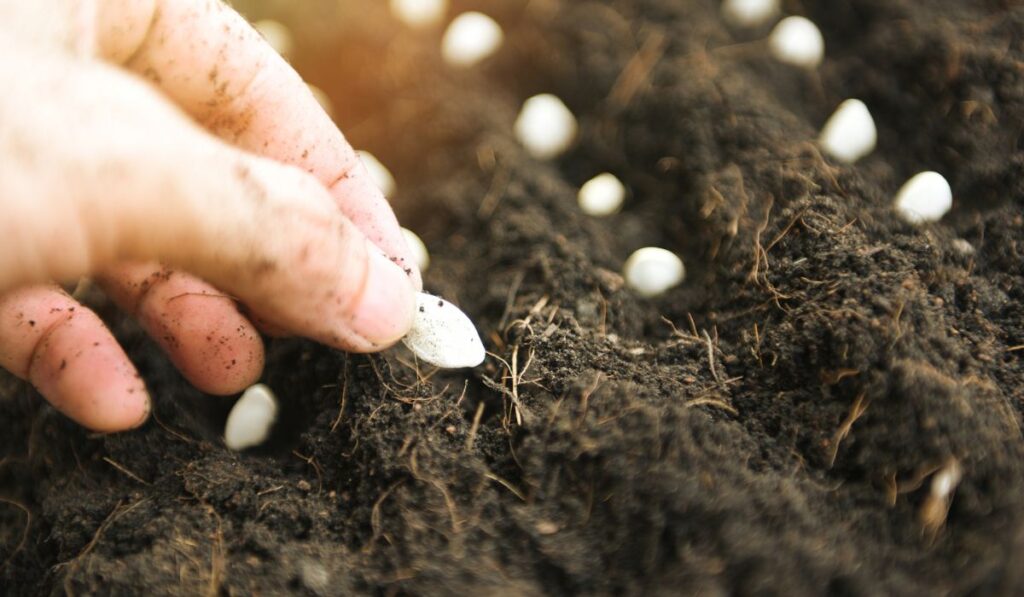Before you start looking for spooky designs to carve into your pumpkin, it’s important to get your hands on a big, sturdy gourd first. Having a home-grown pumpkin patch will provide you with enough fruit to bake pies and cookies, make festive fall decor, carve ghostly Jack-o’-lanterns, and even compete for the best pumpkin prize at the local county fair.
Planting pumpkin seeds any time between late May and early July will give you fully-grown pumpkins in time for Halloween. Plant the seeds five feet apart in mounds in a spot that receives full sun, and make sure they get plenty of water. Prune the vines only after a couple of gourds have formed.
Planting and growing pumpkins can be a time-consuming process, but with a proper routine, you’ll see big, orange gourds in just a couple of months. Let’s look at when and how you should plant pumpkin seeds, whether it’s an easy or difficult process, and how long it will take the seed to grow into a full-sized pumpkin.
When to Plant Pumpkin Seeds

It’s best to plant pumpkin seeds (on Amazon) from late May to early July, so that they’re fully grown by Halloween. You can either plant store-bought seeds or collect them from a pumpkin after carving it.
If you live in a colder climate, then plant the seeds in late May. Conversely, it’s better to sow them in early June if you live in warmer, southern climates.
How to Plant Pumpkin Seeds
It’s best to plant your pumpkin sides in a spot that receives full sunlight and light shade. However, make sure you place them in well-drained soil, as the gourds don’t thrive in soggy soil.
It’s also advisable to check your soil’s pH level with a soil test (on Amazon) and make sure it’s between 6 and 6.8 before planting. Clear the area of any insects, pests, and weeds as well. You can do this by applying weed block two weeks before planting and allowing the weeds to die back naturally.
When it’s time to place the pumpkin seeds into the ground, make sure you do so properly. For best results, plant the seeds one inch deep into the soil.
How Much Space Do Pumpkins Need?
Most pumpkin seed packets come with comprehensive growing instructions, including how much space you should leave between each pumpkin. However, a good rule of thumb is to leave around five feet of space between each plant and place one to two in the middle of the mound.
It’s a good idea to plant smaller pumpkin types two to three feet apart and one inch deep. With smaller varieties, you can plant four to five seeds per mound.
Once the seedlings grow up to three inches tall, thin them, so each hill has only two or three gourds growing on it.
How Long Should You Soak Pumpkin Seeds Before Planting?
Soaking your pumpkin seeds for up to 24 hours before planting can help promote faster germination. Place them in a bowl of clean water and let them sit for a couple of hours before you start the planting process.
However, keep in mind that this step is not necessary. If you’re growing the pumpkins in warm and moist soil, then they should germinate well even if you don’t soak the seeds in water first.
Is It Easy to Grow Pumpkins?
Due to the sheer size of the gourds and the incredible vine growth, pumpkins need plenty of water, fertilizer, and sunlight during their growing seasons. They need a lot of care, and are certainly not a “stick a seed into the soil” and neglect it type of plant.
While they’re not exactly easy to grow, the end result is definitely worth all the effort. Here are a few things to keep in mind for healthy pumpkin growth:
Sunlight Requirements
Plant pumpkin seeds in an area that receives full sun for a large part of the day. Like most garden vegetables, pumpkins also need at least 6-8 hours of direct sunlight each day.
Weeding
Plants are very susceptible to competition, so it’s important to remove as many weeds as possible. However, be careful you don’t disturb the shallow pumpkin root system during removal.
It’s best to add mulch, as it’ll not only prevent weeds but will also help retain soil moisture. Once the vines start growing, they’ll naturally blanket the soil and prevent the growth of any further weeds.
Pest Removal
Keep an eye out for any insects, weeds, and pests, especially during the first few months of the growing season. Once the plant reaches up to one foot tall, fertilize it regularly with a high-quality, nitrogen-based fertilizer.
You can also deter pests naturally by adding a few companion plants, such as oregano, marigolds, and dill.
Pruning
Once you see steady vine growth, start using a fertilizer with a high phosphorus content. After a couple of pumpkins have formed, prune the vines by pinching off their fuzzy ends. This will help with the space and ensure blooming plant growth.
Additional Growing Tips
If you provide your plants with all their basic needs, then it’s highly likely that you’ll see a decent harvest in time for Halloween. However, a bit of extra effort can result in larger gourds and better yields.
Here are a few tips that can help ensure healthier pumpkin growth:
- Use drip irrigation or a soaker hose (on Amazon) to water the ground directly, ensuring that the water doesn’t touch the leaves.
- Use newspaper or cardboard to elevate the gourds off the ground and prevent them from rotting.
- If possible, water your plants in the morning.
- Position the plants along the edge of your garden, so they don’t overtake or compete with other garden vegetables.
- Pinch off the main vines’ tips once they’re two feet long for branching and a higher overall yield.
- If you want to grow larger pumpkins, keep only three or four gourds and remove the rest.
- Avoid planting any root crops near your pumpkin plant.
- Add flowering ornamentals to encourage pollinators.
How Long Do Pumpkins Take to Grow From a Seed?
Pumpkins usually have a growing season that lasts 75 to 100 days. It’s advisable to cut away any leaves that are covering the plant a couple of weeks before harvesting, so the pumpkins have a brighter, more vibrant color.
You can identify a ripe pumpkin by its orange coloring and by checking whether its skin feels hard to the touch. A shriveled and dry stem is also a good sign of a ripe pumpkin.
Once your pumpkins are ripe, wear a pair of gloves and cut about one to four inches off the stem. Remember that if you cut the stem too short, your pumpkin won’t store as long. After this step, place the gourd in the sun for about 10 to 14 days until it hardens and ripens properly.
How Often Should Pumpkins Be Watered?
Pumpkin plants need a lot of water, especially when they’re flowering and forming gourds. Try to give your plant at least one inch of water each week.
If you’ve planted your pumpkins in sandy soil that drains quickly, or if you live in a hot, dry climate, then you might need to water a bit more.
An under-watered pumpkin plant will lose its fruits and flowers to conserve water. To prevent this from happening, try investing in a drip line or soaker hose that directly waters the plant’s roots.
Where Do Pumpkins Grow Best?

It’s very tempting to plant pumpkin seeds as soon as winter ends, but it’s important to remember that these gourds grow best in reliably warmer temperatures. Along with a warm, sunny spot, they also need fertile, well-drained soil to thrive.
You can guarantee a better overall pumpkin yield by performing a soil test, following a proper crop rotation plan, and adding plenty of organic material to the soil.
Here are a few other tips that will help you grow larger, healthier pumpkins:
- Dig a one-foot deep and three-foot wide hole in your garden where you plan to sow your pumpkin seeds.
- Combine manure or compost with the native soil, and add the mixture into the hole.
- Mound up the remaining soil mixture above the hole. You might also need to side-dress the plant with compost after every three weeks, depending on the type of pumpkin.
